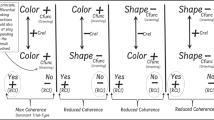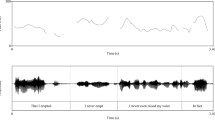Abstract
The year 2007 marked the 50th anniversary of the publication of B. F. Skinner’s Verbal Behavior, a book that by Skinner’s own account was his most important. the received view, however, is that a devastating review by a young linguist not only rendered Skinner’s interpretation of language moot but was also a major factor in ending the hegemony of behaviorism in psychology and paving the way for a cognitive revolution. Nevertheless, in taking stock of Verbal Behavior and behaviorism, both appear to be thriving. This article suggests that Verbal Behavior and behaviorism remain vital partly because they have generated successful practical applications.
Similar content being viewed by others
References
ANDRESEN, J. (1991). Skinner and Chomsky 30 years later or: The return of the repressed. The Behavior Analyst, 14, 49–60.
CHOMSKY, N. (1957). Syntactic structures. The Hague: Mouton.
CHOMSKY, N. (1959). Review of B. F. Skinner’s Verbal behavior. Language, 35, 26–58.
DYMOND, S., O’HORA, D., WHELAN, R., & O’DONOVAN, A. (2006). Citation analysis of Skinner’s Verbal behavior: 1984-2004. The Behavior Analyst, 29, 75–88.
EDELMAN, G. (1987). Neural Darwinism: The theory of neuronal group selection. New York: Basic Books.
GREER, R. D., & ROSS, D. E., (2008). Verbal behavior analysis: Developing and expanding verbal capabilities in children with language delays. Boston: Allyn & Bacon/Merrill.
HALLIDAY, M.A.K. (1985). Spoken and written language. Oxford: Oxford University Press.
HALLIDAY, M.A.K., & HASAN, R. (1985). Tanguage, context, and text: Aspects of language in a social-semiotic perspective. Oxford: Oxford University Press.
HERNANDEZ, E., HANLEY, G. P., INGVARSSON, E. T., & TIGER, J. H. (2007). A preliminary evaluation of the emergence of novel mand forms. Journal of Applied Behavior Analysis, 40, 137–156.
HUNT, M. (1982). The universe within: A new science explores the human mind. New York: Touchstone.
KNAPP, T. J. (1992). Verbal Behavior: The other reviews. The Analysis of Verbal Behavior, 10, 87–95.
LERMAN, D. C., PARTEN, M., ADDISON, L.R., VORNDRAN, C. M., VOLKERT, V. M., & KODAK, T. (2005). A methodology for assessing the functions of emerging speech in children with developmental disabilities. Journal of Applied Behavior Analysis, 38, 303–316.
LOWENKRON, B. (1998). Some logical functions of joint control. Journal of the Experimental Analysis of Behavior, 69, 327–354.
LOWENKRON, B. (2006). An introduction to joint control. The Analysis of Verbal Behavior, 22, 123–127.
MACQUORODALE, K. (1970). On Chomsky’s review of Skinner’s Verbal Behavior. Journal of the Experimental Analysis of Behavior, 13, 83–89.
MCPHERSON, A., BONEM, M., GREEN, G., & OSBORNE, J. G. (1984). A citation analysis of the influence on research of Skinner’s Verbal Behavior. The Behavior Analyst, 7, 157–167.
MIGUEL, C. F., PETURSDOTTIR, A., & CARR, J. (2005). The effects of multiple-tact and receptive-discrimination training on the acquisition of intraverbal behavior. The Analysis of Verbal Behavior, 21, 27–41.
PALMER, D. C. (2006a). On Chomsky’s appraisal of Skinner’s Verbal Behavior. The Behavior Analyst, 29, 253–267.
PALMER, D. C. (2006b). Joint control: A discussion of recent research. The Analysis of Verbal Behavior, 22, 209–215.
ROEDIGER, R. (March, 2004). What happened to behaviorism? Aps Observer.
SAUTTER, R. A., & LEBLANC, L. (2006). Empirical applications of Skinner’s analysis of verbal behavior with humans. The Analysis of Verbal Behavior, 22, 35–48.
SIDENER, D. W. (2006). Joint control for dummies: An elaboration of Lowenkron’s model of joint (stimulus) control. The Analysis of Verbal Behavior, 22, 119–122.
SKINNER, B. F. (1957). Verbal behavior. New York: Appleton-Century-Crofts.
SKINNER, B. F. (1977). The experimental analysis of operant behavior. In R. W. Reiber & K. Salzinger (Eds.), The roots of American psychology: Historical influences and implications for the future (Annals of the New York Academy of Sciences, Vol. 291, pp. 374–385). New York: New York Academy of Sciences.
SKINNER, B. F. (1987). Controversy? In S. Modgil & C. Modgil (Eds.), B. P. Skinner: Consensus and controversy (pp. 11–12). New York: Falmer.
VIRUES-ORTEGA, J. (2006). The case against B. F. Skinner 45 years later: An encounter with N. Chomsky. The Behavior Analyst, 29, 243–251.
WALLACE, M. D., IWATA, B. A., & HANLEY, G. P. (2006). Establishment of mands following tact training as a function of reinforcer strength. Journal of Applied Behavior Analysis, 39, 17–24.
WRIGHT, A. N. (2006). The role of modeling and automatic reinforcement in the construction of the passive voice. The Analysis of Verbal Behavior, 22, 153–169.
WYATT, W. J., HAWKINS, R. P., & DAVIS, P. (1986). Behaviorism: Are reports of its death exaggerated? The Behavior Analyst, 9, 101–105.
YI, J. I., CHRISTIAN, L., VITTIMBERGA, G., & LOWENKRON, B. (2006). Generalized negatively reinforced manding in children with autism. The Analysis of Verbal Behavior, 22, 21–33.
Author information
Authors and Affiliations
Corresponding author
Additional information
I am grateful to Terry Knapp, Ed Morris, Matt Normand, Dave Palmer, and Julie Riggott for their helpful comments on earlier versions of this article and to Norm Somach for suggesting “The Long Goodbye” as a title.
Rights and permissions
About this article
Cite this article
Schlinger, H.D. The Long Good-Bye: Why B. F. Skinner’s Verbal Behavior is Alive and Well on the 50Th Anniversary of Its Publication. Psychol Rec 58, 329–337 (2008). https://doi.org/10.1007/BF03395622
Published:
Issue Date:
DOI: https://doi.org/10.1007/BF03395622




